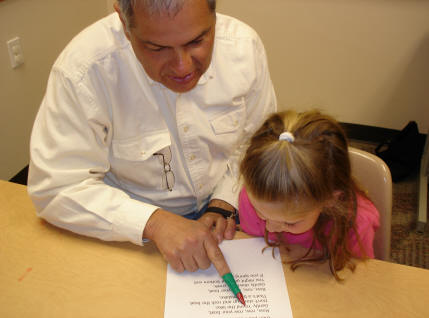 The
auditory-oral approach is based on the concept that society communicates
largely through spoken language (Gatty, 1996). The goal of the
auditory-oral approach is for the child to learn spoken language and to be
able to communicate verbally (Martin & Noble, 1994). The children can look
at the speaker’s face and mouth in order to lipread (Goldberg, 1996).
Children who follow the oral approach are fitted with hearing aids and use
hearing to supplement their speechreading (Gatty, 1996). Ling (1986) stated that
those who are successful followers of the auditory-oral approach “usually
have a good knowledge of spoken language, make use of both verbal and
nonverbal contexts to provide cues on the intent of the message, and are
able to synthesize the partial patterns perceived into a meaningful whole”
(p. 25).
The
auditory-oral approach is based on the concept that society communicates
largely through spoken language (Gatty, 1996). The goal of the
auditory-oral approach is for the child to learn spoken language and to be
able to communicate verbally (Martin & Noble, 1994). The children can look
at the speaker’s face and mouth in order to lipread (Goldberg, 1996).
Children who follow the oral approach are fitted with hearing aids and use
hearing to supplement their speechreading (Gatty, 1996). Ling (1986) stated that
those who are successful followers of the auditory-oral approach “usually
have a good knowledge of spoken language, make use of both verbal and
nonverbal contexts to provide cues on the intent of the message, and are
able to synthesize the partial patterns perceived into a meaningful whole”
(p. 25).
Auditory-oral
programs often are teacher-focused, and children typically attend
preschool classes that have an auditory-oral orientation. Children
often are grouped with other children who are deaf or hard of hearing.
With the advent
of newborn infant hearing screening and subsequent early fitting of
hearing aids and cochlear implants, auditory-verbal and auditory-oral
programs have more similarities than differences.
This explanation
of the auditory-verbal approach is an excerpt from:
Lim, S., & Goldberg, D.M. (2001). Auditory-verbal
graduates: Rationales for choosing cochlear implants or hearing aids and their listening abilities. Unpublished
thesis, The College of Wooster, Wooster, OH.
References:
Gatty, J.
(1996). The oral approach: A professional point of view. In S. Schwartz
(Ed.). Choices in Deafness (2nd ed.). (pp. 163-171). Bethesda, MD:
Woodbine House.
Goldberg, D.M.
(1996). Early intervention. In F.N. Martin & J.G. Clark (Eds.) Hearing
care for children (pp. 287-302). Boston: Allyn and Bacon.
Ling (1986).
Devices and procedures. The Volta Review, 88 (5), 19-28.
